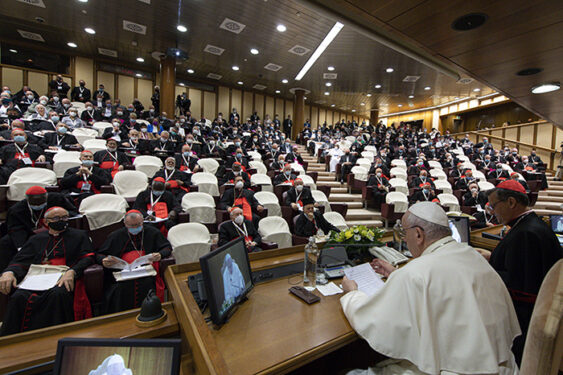PROSPECT HEIGHTS — When Bishop Robert Brennan invited the Diocese of Columbus to an initiative to shape the diocese’s future in early 2021, two things hadn’t happened yet: His appointment to the Diocese of Brooklyn in the fall, and the start of the diocesan phase of the Synod on Synodality.

Bishop Brennan’s new job took him out of Columbus at the outset of the diocesan synod phase in October, leaving the central Ohio diocese without a shepherd to lead the process. There’s a belief, however, that his initiative, “Real Presence, Real Future,” has nonetheless laid the foundation for a fruitful synod process.
“The message for us in getting the word out without the bishop is to kind of continue to ride on the coattails of what he started with ‘Real Presence, Real Future,’ and then helping people understand how synodal that is and how it’s going to play a part in how to participate in the synod,” Father Mike Hartge, the Diocese of Columbus’ synod coordinator, told The Tablet.
The Diocese of Columbus is one of three U.S. Catholic dioceses working through the diocesan synod phase without a bishop. The synod coordinator of at least one other, the Diocese of Gaylord in Michigan, is also confident they’re in position for a productive process and working to ensure they maximize the opportunity. The third, the Diocese of New Ulm, Mew Mexico, has not detailed its plans.
In Columbus, Father Hartge said the synod team is ironing out the details of listening sessions between parishioners and clergy that will begin in March. The “skeleton structure” right now is a meeting per deanery, of which there are 12 in the diocese, with some other meetings for different ethnic groups and groups “on the fringe” to make sure all voices are heard.
The March timeline isn’t far off from many dioceses that are getting into the thick of the listening sessions early in the new year. The March launch, Father Hartge said, is strategic. Logistically it gives them enough time to refine the schedule and advertise to the faithful. Spiritually, they anticipate “people might already be interested in praying and reflecting with one another during Lent.”
As for how “Real Presence, Real Future” figures into it all, Father Hartge said it helps mitigate the possibility for a lack of enthusiasm from parishioners without a bishop encouraging people to participate, and leading synod-related public liturgies.
Facilitators of the fall meetings between parishioners and clergy for the initiative will also do the same for the synod process. Reflecting on what came out of those meetings, Father Hartge acknowledged the feedback wasn’t all positive, though he’s grateful for the candid responses and hopes the synod process will foster similar honesty.
“There’s been a lot of criticism and a lot of constructive feedback to say where we could have communicated better,” Father Hartge said. “And I’m so happy to hear all of that because we’re on a journey together. We’re not going to do it perfectly, but we’re going to do it openly and honestly.”
It’s unknown when the Diocese of Columbus will get a new bishop. Regardless, Father Hartge expects the faithful’s feedback to factor into the future of the diocese beyond the conclusion of the diocesan synod phase in August.
“The whole synod process is trying to remind us that this is not a one-and-done thing,” Father Hartge said. “This is going to be the beginning of a process.”
A New Process, A New Bishop
Andrew Moe, the director of faith formation and synod coordinator in the Diocese of Gaylord, also chose March to begin the synod listening sessions for similar logistical reasons and the fact that the observance of Lent could add “depth” to the consultations.
March also happens to be the month that Father Jeffrey Walsh will take over as the diocese’s sixth bishop, though it’s unclear how much involvement he’ll have in the synod process if any at all. Moe said, either way, Father Walsh’s arrival could add a “boost” and “create a little bit more excitement and enthusiasm for the process.”
In the meantime, Moe and the diocese’s synod team are finalizing simplistic teaching documents to distribute to each of the parishes as an easy resource for parishioners, as well as written questionnaires and digital questionnaires.
Moe acknowledged the challenge of planning without a bishop is the lack of direction. He’s confident, however, that the combination of easy-to-understand resources, different methods for feedback, and allowing each parish to take the reins on formatting and scheduling their listening sessions in a way that works best for that parish community is the best approach to compiling the most comprehensive feedback from parishioners.
“We want everybody to be open to one another and have the ability to be frank about their experience in the church and to really feel a sense of community when they’re coming together on these things,” Moe said. “We want everybody to feel like they’re being heard and that they have a place, but also to know what exactly is the intention of this process.”
In an extra step that no other diocese in the U.S. has to face, the final report of the feedback will be presented to Father Walsh as a resource while he adjusts to his new diocese.
“These results are going to be made as public as they can be because we want people in the parishes to be able to see that their input is being heard,” Moe said.
